|
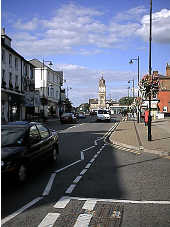
Newmarket's
Clocktower
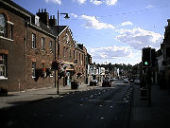
Newmarket High Street
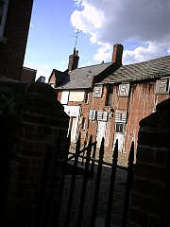
The old stables
by Palace House
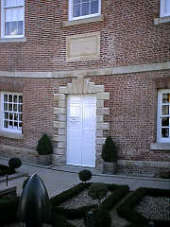
Doorway to
Palace House
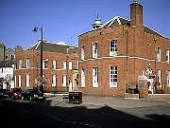
The Jockey Club and the
National Horseracing
Museum
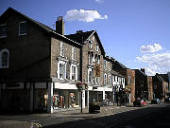
Palmer's Department
Store on the site of
James Ist's Palace
|
Cromwellian Britain - Newmarket
Newmarket is best known as the home of English flat racing, a corner of Suffolk that nudges into Cambridgeshire. The town’s association with racing and royalty extends back into the 17th century. John Sutton’s article expalins in depth the connections between the town and its 17th century history.
Royal Newmarket: yes, ever since February 1605 when James I made his first visit to the town – then described as a ‘poor little village’ – Newmarket had become a resort of kings. The crucial event in this remarkable transformation in the town’s fortunes was, of course, the construction of Newmarket Palace by King James between 1606 and 1610. By all accounts a substantial pile, the palace complex occupied about an acre of land, extending from the High Street proper – somewhere between the present Palmers’ store and the Jockey Club – to All Saints’ churchyard. The royal buildings included not only a great presence chamber and long gallery but an elaborate range of outhouses, i.e. kitchens and stables as well as a brewhouse and dog-kennel. There was also a covered tennis court. An even more splendid addition was made to the Jacobean palace in 1619 when the royal architect Inigo Jones was commissioned to build a new lodge for the Prince of Wales – the future Charles I. Built of brick and stone, the Jonesian appendage was three storeys high and extremely Italianate in style, as shown by two contemporary sketches of the Prince’s Lodging. Yet whilst clearly influenced by Palladian architectural motifs, the Newmarket Lodging was still quintessentially English, perhaps best epitomised by the tall dormer windows and the Prince of Wales’ feathers on the crests in the pediments. A more tangible demonstration of the royal presence in early Stuart Newmarket could not be envisaged than this majestic building.
And what a superb setting it made for James I’s many ‘sporting journeys’ to the town accompanied by foreign ambassadors and royal favourites such as George Villiers, Duke of Buckingham, to say nothing of the large retinue of Privy Councillors, officials, household servants and other dependants. ‘Away to Newmarket, away to Newmarket’ was the most popular cry to be heard among King James’s courtiers. Here they could ‘devise all the means they could to make themselves merry’, whether by hunting or engaging in tilts and masques. This perpetual round of gaiety continued during the reign of Charles I, who spent as much time as he could in Newmarket. The king, we are told, would ride around the surrounding countryside ‘in cheerful mood’, boasting that he never enjoyed such good health as he did in Newmarket. Indeed, one of his more intimate confidants described Newmarket as ‘the sweetest place in the world’. But these halcyon days were soon to be interrupted by the approaching storm clouds of civil war and revolution and with the downfall of the monarchy Newmarket underwent a serious decline.
It is not often realised that the fratricidal conflict which engulfed England in 1642 effectively began in Newmarket, for it was here, in the royal palace in early March of that year, that King Charles had a stormy confrontation with a parliamentary deputation sent from London to demand that he surrender his control over the country’s armed forces. ‘By God not for an hour’, he angrily retorted. ‘You have asked such of me that was never asked of a King!’ The die was cast. Only armed conflict could now resolve the dispute between the king and his parliament. During the ensuing bloody confrontation ‘loyal hearts’ in Newmarket espoused the royal side; for example in the summer of 1642 some of the townsfolk forlornly attempted to raise troops for the king, while six years later, at the height of the second civil war, there was another abortive rising on his behalf which saw serious fighting in the market place.
But this was as nothing compared with Newmarket’s involvement in the tragic events leading to the king’s eventual trial and execution. In early June 1647 Charles was seized at Holdenby House in Northamptonshire by Cornet George Joyce – with Cromwell’s connivance – and brought prisoner to Newmarket. Here he found the entire New Model Army had been massed, and surrounded by this ring of steel, he was kept under house arrest in his own palace for nearly a fortnight. However, his stay was not altogether unpleasant, for he was permitted to go riding in his coach on Newmarket Heath which, his attendant Sir Thomas Herbert informs us, ‘for good air and pleasure gives place to no other in this great Island’. We are also told that a great concourse of people, including many of the gentry from Suffolk and the surrounding counties, flocked to see the king, especially when he ‘was at Dinner or Supper’ in the Presence Chamber which reverberated with their prayers and ‘loud acclamations’ for his safety.
To no avail, for ahead of Charles lay the block, which spelt the doom of the royal palace in Newmarket. As is evident from a survey made in 1649, this now fell into disrepair and its fate was sealed when it was sold off the following year to a consortium of seven gentlemen including the notorious regicide Colonel John Okey, who pulled down most of the buildings in an orgy of iconoclastic vandalism. By the end of the Interregnum the Jacobean palace was a shadow of its former self: the resplendent Prince’s Lodgings, for example, had been completely razed to the ground. Even the parts of the palace which were still standing, such as the brewhouse and stables, were in a pretty dilapidated state. Only the garden ‘was not much altered’. Newmarket’s link with the monarchy seemed broken forever.
‘When the King enjoys his own again!’ How Newmarket must have revelled in the first fine, careless rapture of Restoration England! Especially so as in those ‘days of ease when now the weary sword/ Was sheathed, and luxury with Charles restored.../ Newmarket’s glory rose...’. No British monarch has had such a close and intimate association with Newmarket as Charles II. He simply adored the place, as shown by the fact that he visited it virtually every spring and summer from March 1666 until his death in February 1685. The essence of the king’s love affair with Newmarket was its informality – here he could ‘put off the King’, relax and be a ‘jolly blade’. Thus he was often to be seen sauntering down the High Street with an air of summer relaxation, mingling freely with the crowds of sightseers and allowing everyone to speak to him as they pleased, so that in the words of Sir John Reresby, ‘he lett himselfe down from Majesty to the very degree of a country gentleman’. Newmarket was now the king’s holiday home and thanks to his generous patronage it now developed into a fashionable centre for the beau monde throughout England. As is well known, the Merry Monarch was a liberal patron of the turf. To this day, one of the Newmarket racecourses is known as the Rowley Mile, after the stallion called Old Rowley which the king himself rode during many gallops over the heath. It was Charles, too, who established the race run on every second Thursday in October: the celebrated Town Plate. Indeed, Charles was such a devotee of horseracing that a small summer-house known as ‘the King’s Chair’ was built on the top of Warren Hill, just east of Newmarket, so that he could watch the jockeys put their steeds through their paces. He also enjoys the distinction of being the first man to establish racing stables in the town – the famous Palace House Stables, reputedly ‘the oldest training establishment in the world’. For this alone Newmarket owes an immense debt to King Charles II.
But the Merry Monarch made another contribution to the history of Newmarket which has not received due recognition. Like his grandfather before him, Charles decided to build a palace in the town. Construction began in 1668; the architect was William Samwell, although there is a tradition that the great Sir Christopher Wren was involved in the work, if we are to believe a delightful anecdote dating from the eighteenth century. This relates that when the new edifice was completed Charles found the ceilings too low – he was over six feet tall – and duly complained to Sir Christopher who, a much shorter man, brazenly claimed they were quite high enough. Whereupon, we are told, ‘the King squatted down to his height and creeping about in this whimsical posture cried “Aye, Sir Christopher, I think they are high enough”’!
Charles II’s residence occupied a slightly different site from that of the Jacobean palace; it lay slightly further up the High Street where a supermarket and the United Reform Church now stand. An eighteenth century plan shows that the second Caroline palace was centred around a large courtyard with a projecting wing to the south-west. To judge by contemporary accounts it was not an impressive structure: according to Cosmo II, Grand Duke of Tuscany, who visited Newmarket in 1669, ‘the King’s house, compared with other seats of the English nobility, does not deserve the name of a royal residence’, while only a year later the diarist John Evelyn proved equally disparaging, saying it was ‘meane enough, and hardly capable for a hunting house, let alone a royal palace!’
Such adverse comments, however, should not be allowed to detract from the major role which King Charles II’s palace played in the life of not just Newmarket but England as a whole in the second half of the seventeenth century. During the Merry Monarch’s frequent visits here the mansion became the focus of Court festivities, as John Evelyn discovered in October 1671 when he found it alive with ‘dancing, feasting, revelling’, though, he added with more than a whiff of puritanical disapproval, ‘more resembling a luxuriously abandoned rout than a Christian Court’. Stirring national events also punctuated the life of the palace, of which perhaps the most memorable was the visit here in October 1677 of William of Orange to arrange his marriage to the king’s niece, princess Mary, a match which was to have momentous consequences for the country in the Glorious Revolution of 1688. Apparently a great crowd gathered to witness the arrival of the young Dutch prince who was ‘mightly well received’ by the king and his future father-in-law, James, Duke of York. This was not to be William’s only visit for he returned to Newmarket as the all-conquering hero in October 1695. Now King of England, he was given a rapturous welcome; in the words of a contemporary ballad:
‘He came to the Town of Newmarket
Where Monarchs have formerly been
The greatest of Men, with loyalty then,
Came forth to usher him in...
Thus did they receive him with Triumph and Joy,
Their loud Acclamations were Vive le Roy!’
Needless to say the royal guest was sumptuously entertained at Newmarket Palace and his stay here was commemorated long afterwards, for his bedroom on the first floor of the south-west wing is still clearly shown in an early eighteenth century map of the palace complex. Sadly, most of Charles II’s residence was swept away in the Regency period, but a small portion still exists in the two lower storeys of the nineteenth century house known as Palace House Mansion, including William III’s bedroom; a fortunate survival. It is extremely fitting that the only extant part of King Charles II’s palace is now being restored by the Forest Heath District Council. Vive le Roi! Let the king enjoy his own again!
By John Sutton
Note
Apart from the silent correction of a handful of minor presentation errors, the articles are reproduced here as they first appeared; in other words, they have not been reviewed, recast and up-dated. We are most grateful to the authors for giving permission for their articles to be reproduced in this way. It must be stressed that, in common with all the text found on this site, this material is strictly copyright to the Cromwell Association and the individual authors.
|
